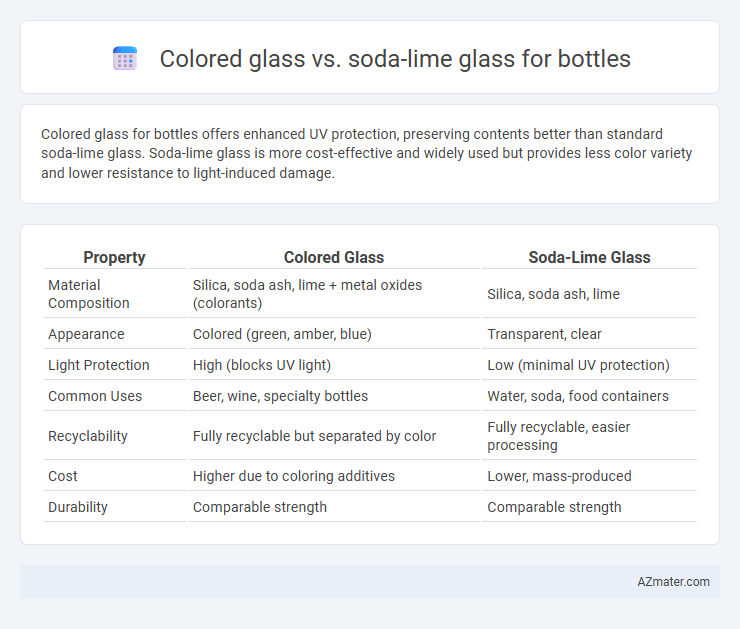Colored glass for bottles offers enhanced UV protection, preserving contents better than standard soda-lime glass. Soda-lime glass is more cost-effective and widely used but provides less color variety and lower resistance to light-induced damage.
Table of Comparison
| Property | Colored Glass | Soda-Lime Glass |
|---|---|---|
| Material Composition | Silica, soda ash, lime + metal oxides (colorants) | Silica, soda ash, lime |
| Appearance | Colored (green, amber, blue) | Transparent, clear |
| Light Protection | High (blocks UV light) | Low (minimal UV protection) |
| Common Uses | Beer, wine, specialty bottles | Water, soda, food containers |
| Recyclability | Fully recyclable but separated by color | Fully recyclable, easier processing |
| Cost | Higher due to coloring additives | Lower, mass-produced |
| Durability | Comparable strength | Comparable strength |
Introduction to Colored Glass and Soda-Lime Glass
Colored glass for bottles is produced by adding metal oxides or other colorants to the molten glass, enhancing UV protection and aesthetic appeal while maintaining durability. Soda-lime glass, the most common type for bottles, consists primarily of silica, soda, and lime, offering excellent workability and cost-effectiveness but limited UV resistance. Both materials serve essential roles in packaging, with colored glass favored for preserving light-sensitive contents and soda-lime glass widely used due to its availability and recyclability.
Chemical Composition Differences
Colored glass bottles contain metal oxides such as iron, cobalt, chromium, or manganese, which impart hues by altering the glass matrix, whereas soda-lime glass is primarily composed of silica (SiO2), sodium oxide (Na2O), and lime (CaO) with minimal colorants. The presence of these trace metal oxides in colored glass not only affects optical properties but also enhances UV protection, which is absent or minimal in standard soda-lime glass used for transparent bottles. Differences in chemical composition influence durability, with colored glass generally exhibiting higher resistance to light-induced degradation compared to soda-lime glass.
Manufacturing Processes Compared
Colored glass bottles require the addition of metal oxides or other colorants during the melting process, which necessitates precise control of temperature and mixing to ensure uniform color distribution. Soda-lime glass production involves melting raw materials like silica, soda ash, and limestone at high temperatures, followed by forming and annealing without the complexity of added pigments. The introduction of colorants in colored glass can influence melting characteristics and cooling rates, making the manufacturing process more intricate compared to standard soda-lime glass bottles.
Visual Appeal and Branding
Colored glass bottles enhance visual appeal by offering distinctive hues that reinforce brand identity and attract consumer attention on shelves. Soda-lime glass, typically clear or lightly tinted, provides versatility but may require printed labels to achieve similar branding impact. Choosing colored glass enables brands to create a strong, recognizable presence through integrated color, improving perceived product value and shelf differentiation.
Durability and Strength Analysis
Colored glass bottles typically offer enhanced durability due to additives like metal oxides that improve resistance to UV radiation and physical impacts, making them less prone to degradation over time compared to soda-lime glass. Soda-lime glass, the most common bottle material, provides adequate strength for everyday use but is generally more susceptible to chipping and breakage under stress. The presence of colorants in colored glass increases its structural integrity by adding chemical stability, which is essential for protecting contents sensitive to light exposure.
UV Protection and Light Filtration
Colored glass bottles provide superior UV protection compared to soda-lime glass, effectively filtering harmful ultraviolet rays that can degrade light-sensitive contents like beverages and pharmaceuticals. The pigmentation in colored glass, such as amber, green, or cobalt blue, absorbs and blocks specific light wavelengths, enhancing product shelf life and preserving quality. Soda-lime glass, being mostly clear or lightly tinted, offers minimal UV filtration, making it less ideal for products requiring extended protection from light exposure.
Environmental Impact and Recycling
Colored glass bottles, commonly made from soda-lime glass with added metal oxides for pigmentation, have a similar environmental impact to clear soda-lime glass but can complicate recycling due to the need for color separation to maintain batch purity. Soda-lime glass, widely used for bottles, is highly recyclable and benefits from well-established recycling streams, resulting in significant energy savings and reduced raw material extraction when recycled. Recycling colored glass bottles reduces landfill waste and energy consumption, but the complexity of color sorting can cause inefficiencies and higher processing costs compared to clear soda-lime glass recycling.
Cost Considerations in Production
Colored glass bottles often incur higher production costs compared to soda-lime glass due to the addition of metal oxides and pigments, which increase raw material expenses. Soda-lime glass remains the most cost-effective option for bottle manufacturing because of its abundant availability and lower energy requirements during melting and forming. Manufacturers must weigh the premium price of colored glass against its marketing benefits and protective qualities for light-sensitive contents.
Applications and Industry Preferences
Colored glass is widely preferred in the beverage industry for bottles due to its ability to protect contents from UV light, preserving the quality of products like beer and wine. Soda-lime glass, favored for its cost-effectiveness and ease of production, is commonly used in packaging for water, soft drinks, and food items. Many manufacturers choose colored glass for premium products requiring light protection, while soda-lime glass dominates mass-market applications due to its recyclability and versatility.
Choosing the Right Glass for Bottling Needs
Colored glass, such as amber or green, offers superior protection against UV light, making it ideal for preserving light-sensitive beverages like beer and certain wines. Soda-lime glass is more cost-effective and widely used for clear bottles, providing good durability and clarity but less protection from light exposure. Choosing the right glass depends on balancing factors like product sensitivity, cost considerations, and shelf appeal, with colored glass enhancing product longevity and soda-lime glass offering economic benefits.

Infographic: Colored glass vs Soda-lime glass for Bottle
 azmater.com
azmater.com